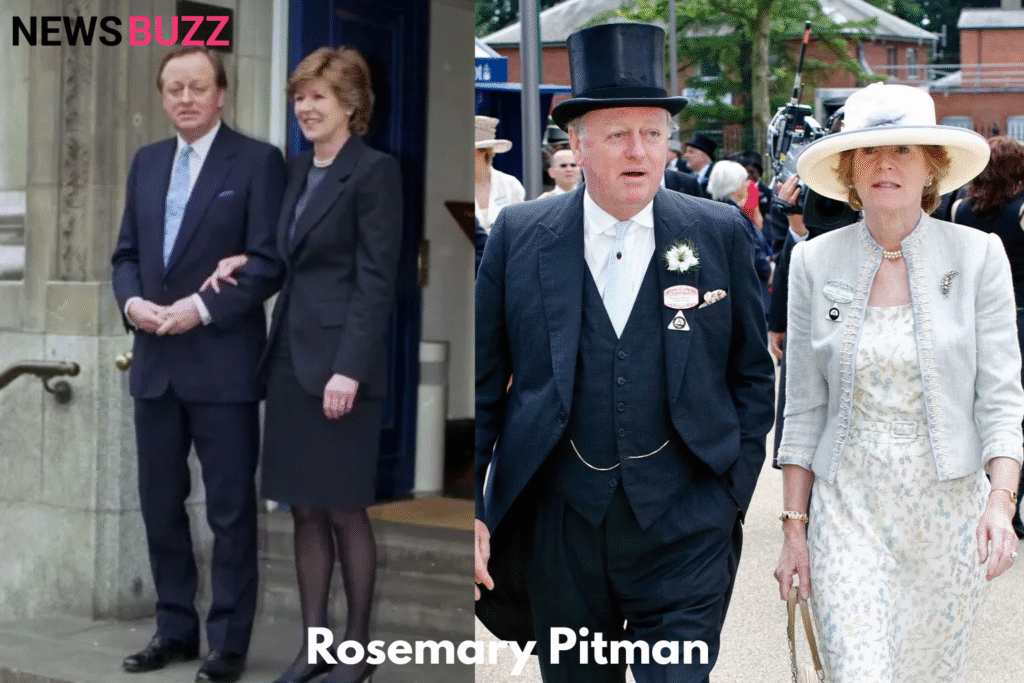Introduction
Rosemary Pitman was a woman of grace, resilience, and understated elegance. Known most publicly as the second wife of Brigadier Andrew Parker Bowles—former husband of Queen Camilla—Rosemary lived a life beyond royal associations. She was a passionate garden designer, a committed mother, and a quiet force of dignity through both joy and adversity.
Though her name gained prominence due to her marriage into a high-profile family, Rosemary Pitman’s story is far more compelling than a royal footnote. Her life reflected emotional strength, creative expression, and unwavering love for nature and family. This article explores the many layers of her journey—from early roots to final years—capturing her essence for readers and researchers alike.
Quick Bio
| Full Name | Rosemary Dickson Pitman Parker Bowles |
|---|---|
| Born | 17 June 1940, Northumberland, England |
| Died | 10 January 2010, Wiltshire, England |
| Profession | Garden Designer |
| Spouse(s) | Hugh Pitman (div.), Andrew Parker Bowles (m.1996) |
| Children | William, Henry, and Thomas Pitman |
| Known For | Elegance, garden design, resilience |
Also Read: Chris Eubank: The Fearless Champion Who Redefined British Boxing with Pride and Controversy
Rosemary Pitman: Early Life and Personal Background
Childhood and Education
Born in Northumberland in 1940, Rosemary Dickson was raised in a traditional and respectable English family. She received her education at St Mary’s School, Ascot, a well-regarded institution known for nurturing refined values and intellectual curiosity.
From a young age, Rosemary was drawn to the outdoors. Her appreciation for the natural world and its beauty later blossomed into a professional interest in garden design. While much of her early life remained outside public scrutiny, it was characterized by warmth, cultural values, and a growing passion for creativity.
Marriage to Hugh Pitman and Family Life
Rosemary married Lieutenant Colonel Hugh Pitman, a respected British Army officer. During their marriage, they lived between England and various overseas postings. Together, they had three sons: William, Henry, and Thomas Pitman.
While she prioritized family life, Rosemary continued cultivating her passion for gardens and country living. She maintained strong bonds with her children and was known for creating a nurturing, well-grounded home. Eventually, however, her marriage to Hugh ended in divorce—handled quietly and with dignity.
A New Chapter: Life With Andrew Parker Bowles
Second Marriage in the Public Eye
In 1996, Rosemary married Andrew Parker Bowles, a retired British Army Brigadier and former husband of Camilla, now Queen Consort of the United Kingdom. Their marriage brought Rosemary into the peripheral orbit of the British royal family, though she remained largely away from the media spotlight.
Despite public curiosity, Rosemary and Andrew chose a low-key ceremony at the Chelsea Register Office, followed by a private blessing. Together, they shared a tranquil life in Wiltshire, far from palace intrigue and closer to the countryside they both adored.
Harmonious Blended Family
Rosemary gracefully navigated her new role within a blended family that included Andrew’s children with Camilla. Her warmth and composure helped maintain harmony and continuity, especially during public events or family milestones.
Her approach was marked by restraint and quiet confidence. Rather than seeking attention, she allowed her actions—thoughtful presence, elegant demeanor, and commitment to family—to speak on her behalf.
Personal Passions: Garden Design and Country Life
Creative Spirit in Garden Design
Rosemary Pitman wasn’t just a homemaker or social figure—she was an accomplished garden designer. With a deep love for English flora, structured landscapes, and artistic planting, she created beautiful, livable outdoor spaces for clients and communities alike.
Gardening was both a career and a personal escape for her. Even in her later years, Rosemary was often seen tending her own garden, finding peace and purpose among the plants. Her works blended classic English style with personal expression, earning quiet admiration in gardening circles.
Equestrian Interests and Community Involvement
Beyond gardening, Rosemary shared her husband’s love for horses and countryside life. She often attended equestrian events and maintained involvement in local activities. In her Wiltshire village, she was known as a kind and active presence—never boastful, always thoughtful.
Whether volunteering, organizing local events, or mentoring younger designers, she contributed meaningfully without demanding credit. Her humility, combined with personal grace, made her a cherished member of every circle she entered.
Final Years: Illness, Strength, and Farewell
Courageous Battle With Cancer
In the 2000s, Rosemary was diagnosed with cancer, and she fought a prolonged, four-year battle. Despite undergoing intense treatments, including chemotherapy and radiotherapy, she continued to engage with life as fully as she could.
Those close to her remember her bravery, dignity, and refusal to let illness define her. She remained at home during most of her final years, drawing comfort from familiar surroundings, her garden, and her family.
Passing and Private Funeral
On 10 January 2010, Rosemary Pitman passed away peacefully at her Wiltshire home at the age of 69. Her funeral took place at St Aldhelm’s Catholic Church in Malmesbury, attended by family and close friends. Her ashes were later scattered in her garden, a deeply symbolic act reflecting her love for the natural world.
Even in death, Rosemary’s farewell was modest yet deeply meaningful—true to how she had lived her life.
Rosemary Pitman’s Enduring Legacy
Celebrated for Grace, Not Glamour
While not a celebrity in the traditional sense, Rosemary Pitman became a symbol of elegant strength. She managed the complexity of public association without ever seeking attention. Her legacy isn’t in headlines—but in the gardens she shaped, the children she raised, and the kindness she quietly extended.
She is remembered as a loving wife, devoted mother, creative professional, and courageous individual who faced life’s most difficult challenges with unwavering dignity.
Positive and Negative Reflections
Positive: Rosemary’s life was marked by grace, creativity, and resilience. Her love for nature, loyalty to family, and elegant presence made her deeply respected.
Negative: The limited public record of her achievements leaves gaps in the recognition she truly deserved. Additionally, her life was cut short by illness, ending a legacy that could have continued to flourish.
Conclusion
Rosemary Pitman’s story is one of quiet power. In a world that often celebrates loudness and fame, she lived differently—favoring substance over spotlight, depth over drama. Whether designing a garden or building a home, she gave her all with love and devotion.
Her legacy endures not only in the public record but in the memories of those who knew her and the lives she touched. Rosemary Pitman may have been known to the world through marriage, but she is remembered for who she truly was—a woman of profound strength, beauty, and grace.
Frequently Asked Questions (FAQ)
Who was Rosemary Pitman?
Rosemary Pitman was a British garden designer and the second wife of Brigadier Andrew Parker Bowles. She was known for her elegant personality, love for nature, and family values.
When was Rosemary Pitman born and when did she die?
She was born on 17 June 1940 and passed away on 10 January 2010 at the age of 69.
Did Rosemary Pitman have children?
Yes, she had three sons—William, Henry, and Thomas—from her first marriage to Hugh Pitman.
What was Rosemary Pitman known for professionally?
She was an accomplished garden designer with a strong reputation for classic English landscaping and natural elegance.
How did Rosemary Pitman die?
She died after a four-year battle with cancer and was laid to rest in Wiltshire, with her ashes scattered in her garden.



